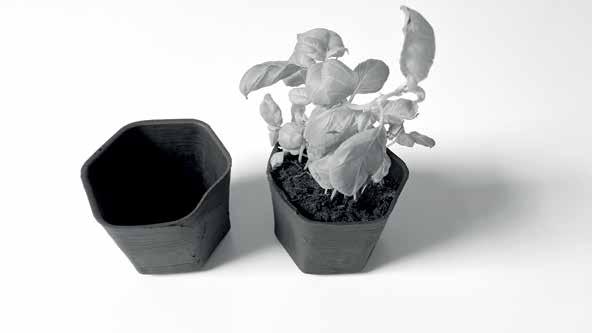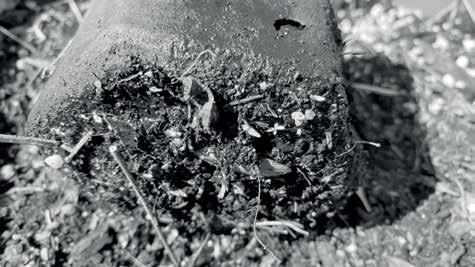
6 minute read
BIOECONOMY
Biocarbons – giving forestry ‘waste’ a second life
Michael Sernatinger of German start-up Carbonauten explains their circular economy model of harnessing EXPLAINER carbon as a raw material. Edited by Stef Kaiser. Carbonisation: a pyrolytic process where biomass
Imagine a world – a world made of CO2. Where houses and streets store CO2 and plastic in the forest becomes fertiliser. Where residual biomass is a valuable raw material other than woodfuel. Carbonauten, a startup from southern Germany, plans to create this world, generating new value streams for forest owners and farmers.
In an ideal world, when trees are felled, as much of the wood resource as possible is destined to long-life timber products, ensuring that the atmospheric carbon sequestered by the trees remains stored in timber in the longer term. In a less-than-ideal-world, however, part of the carbon sequestered by trees is lost after felling – when firewood is burned or when waste biomass rots and releases its embedded carbon.
What if there was way to turn residual biomass of all kinds – including mixed with other materials – into long-life products and keep wood carbon locked up for longer? For the forestry and timber industries, this would mean creating an alternative to traditional biomass markets by tapping into the bioeconomy.
Carbonauten developed a system where pyrolytic carbonisation of residual biomass produces solid biocarbons, renewable energy, and a pyrolysis oil – beside the climate service of prolonging carbon storage in the form of biocarbons.
Waste biomass: sought-after feedstock for the bioeconomy
For this article, we define ‘residual biomass as wood fibre material resulting from harvesting or wood processing which is normally discarded or burned and does not currently have a value in the context of the cascade of wood use. Residual biomass does have a potential value as feed stock for the bioeconomy, meaning it can be turned into new products through processes such as carbonisation. It is important to highlight once more that ‘residual’ biomass refers to biomass that is an underutilised by-product of industries such as wood processing, forestry or farming and would otherwise be discarded as waste.
In forestry and timber processing, examples of residual biomass are beetle or otherwise diseased wood, green cuttings, brash and branches left on harvesting sites, sawmill by-products, waste wood and biomass contaminated with plastics, such as roadside green cuttings.
Currently, some of these products will go into traditional biomass/ woodfuel markets. The bioeconomy has the potential to offer a different market route for residual biomass, with the added value of carbon in biomass being retained in solid products – an additional opportunity to turn waste material into a raw material. gets turned into biocarbon through gasification. Pyrolysis is the thermal decomposition of materials at elevated temperatures in an inert atmosphere. It involves a change of chemical composition.
Pyrolysis oils: a dark brown liquid made from a multitude of chemical compounds. In addition to being used as a biofuel or heating component, pyrolysis oil can be used as a raw material source for chemical applications.
A binder or binding agent is any material or substance that holds or draws other materials together to form a cohesive whole mechanically, chemically, by adhesion or cohesion. Examples are bio or fossil polymers, minerals, silicates or proteins.
The process used by Carbonauten binds the carbon contained in biomass into valuable products
Carbonisation turns waste into three products
Woody biomass consists of a lot of different valuable fractions. In particular, three fractions can be removed from the biomass by pyrolysis in only one process step. Three products derived from one process: 1. The pyrolysis gas is used to generate renewable energy, which could be used for both thermal use and electricity (ideally on-site).
Traditional use of biocarbons as Terra Preta
One of the more traditional applications of biocarbons is their use in agriculture and forestry as a water buffer and a nutrient store. The so-called ‘Terra Preta’ is a mixture of carbon, minerals and compost, an indigenous technique developed in the Amazon to help the normally nutrient-poor tropical soils to achieve maximum soil fertility.
Terra Preta is a man-made superfertiliser produced without any chemical substances. The carbons act like a sponge for microorganisms and help to build up humus and the associated soil fertility. In addition, the increased humidity prevents the emission of greenhouse gases from the soil. The carbons can also be absorbed into a soil substrate and promote the growth and stability of trees in nurseries.
For this application, only pure residual biomass (ie free of contamination with plastics) can be used as feedstock.
NET Materials®: Biocarbons used in nurseries and tree establishment
An interesting example of the use of NET Materials® made from biocarbons are the biodegradable plastic products, which have relevant applications in the forestry sector. Biologically dissolving plant pots behave like plastic pots but break down after a definable period of time (this can set for a few days to several years) and avoid waste production from tree establishment. In addition, the carbon ends up in the soil and thus acts like a natural soil substrate. The same applications can also be used for tree shelters, bite protection, or agricultural films.


2. The pyrolysis oil is a raw material for the bioeconomy 3. The solid biocarbons which can be processed into innovative NET Materials® or, more traditionally, into soil fertiliser. Biocarbons and their applications in forestry are the focus of this article.
Biocarbons from residual biomass
Biocarbons are bound carbon and thus, as a solid material, offer a climate-positive contribution to combating the climate crisis. Biocarbons can be used in various applications in the soil or in products for the forestry and timber sector.
One ton of pure biocarbons can store the equivalent of up to 3.3 tons of CO2. If used in soils or animal feed, they can furthermore help to avoid other greenhouse gases like methane. (The technical explanation for this is beyond the scope of this article, but see the section on Terra Preta above).
The innovative NET materials®, developed by Carbonauts, are biocarbons combined with various binders. Binders can be biopolymers, fossil polymers (ideally recycled), silicates, minerals and even protein.
Besides, biocarbons can also substitute a range of fossil materials and, when added to plastic products, can improve their quality by making them more UV-resistant, more robust and lighter.
And the best of all: biocarbons are even cheaper than existing fossil binders. So, the dilemma of profitability and sustainability is solved in one product.
Our vision: more biocarbons used, more CO2 stored
The business models of biocarbons is totally disruptive. Contrary to fossil-based raw materials, we can say that “the more, the better” – the more biocarbons you use, the more CO2 you store permanently”. “The more, the better” also means the more different biomasses that are used, the more different biocarbons can be produced.
Carbonauten’s vision goes much further, into totally new products with totally new binders beside plastic. We want biocarbons to become a mainstream rawmaterial to be used in all aspects of our lives. Having buildings and streets made of CO2. But also bricks, foams and facade elements will change from what we know today. www.carbonauten.com










